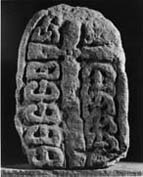Select a site alphabetically from the choices shown in the box below. Alternatively, browse sculptural examples using the Forward/Back buttons.
Chapters for this volume, along with copies of original in-text images, are available here.
Object type: Grave-marker
Measurements: H. 36.2 cm (14.25 in); W. 42.5 cm (17.7 in); D. 12.5 cm (4.9 in)
Stone type: Medium-grained, massive yellow/grey sandstone
Plate numbers in printed volume: Pl. 229.1288-1291
Corpus volume reference: Vol 1 p. 231
(There may be more views or larger images available for this item. Click on the thumbnail image to view.)
There is a flat-band moulding round each of the broad carved faces.
A (broad): The top right corner is broken. A cross, type A12, on a long stem and with a shallow central boss quarters the face. In the top left spandrel is a triquetra knot, in the top right spandrel a knot the type of which is obliterated. Below the cross-arms are two panels of ring-chain. On the left the flattened oval links are separated, linked only by the straight `chain'; on the right the rings are circular and interlock with each other as well as being linked by the chain (G. I., fig. 26cv).
B, D and E (narrow sides and top): Indecipherable plait or ring-chain.
C (broad): A cross, type A12, with shallow central boss quarters the face. In the top left spandrel is a bungled knot, in the top right a triquetra. Below the cross-arms on the left are three elements of straight line patterns, on the right two Stafford Knots linked by long glides.
This type of grave-marker is commoner in Durham than in Northumberland (Introduction, p. 7). A particularly close parallel for the cross shape and ornamental formula is Elwick Hall 2. This is the only such grave-marker to attempt a version of the Scandinavian ring-chain pattern.



